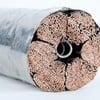The Changing Landscape of Medicine & Healthcare
Featured Product from New England Wire Technologies Corporation
The Changing Landscape of Medicine & Healthcare
Embracing the disruptive technologies of the future
Technology is changing the world in dramatic fashion and it’s doing so at a rate of change unparalleled in history.
China’s Micius satellite has demonstrated quantum entanglement of photons separated by 1200 km of space, leading researchers one step closer to building a quantum network in space. Autonomous vehicles have grown from science projects to a full-fledged industry. Forecasters predict privately-owned vehicles will be replaced by fleets of autonomous rental cars that will carry people to work, to the grocery and provide transportation-as-a-service in a few short years. With the advent of reusable rocket engines and stages, companies are investing in research that will bring hypersonic planes flying at 3,500 miles per hour capable of streaking across the Atlantic in forty minutes.
Many of these disruptive technologies could be found only in science fiction just a decade or two ago. Safety, ethical and other issues tend to slow the rate at which the medical and healthcare field can change. Nevertheless, technology is having profound impact; it’s changing basic assumptions and ways of thinking from those long-held by most of the medical and scientific community.
Empowered Patients Self-Diagnose
During the 23rd century, Dr. Leonard “Bones” McCoy of Star Trek fame used a medical “tricorder” to diagnose illness, injury and collect vital signs by passing nothing more than a hand-held scanner over the patient’s body. In April 2017, Qualcomm announced its Qualcomm Tricorder Xprize when it awarded $3.5 million to two companies for their 21st century versions of that long-sought-after device.
The brainchild of Final Frontier Medical Devices, its DxtER device won first place and took home $2.5 million. DxtER takes measures of blood pressure, oxygen saturation, body temperature, respiratory rate, and heart rate variability. In addition, once it completes clinical trials and gets FDA approval, it’s expected to diagnose mononucleosis, pertussis and hypertension as well as long list of conditions including atrial fibrillation, diabetes, COPD, anemia, sleep apnea and others—34 conditions in all.
In second place with a $1 million award, the Dynamical Biomarkers Group’s device performs blood, urine, breath and glucose testing among others. Like DxtER, it intends to diagnose a range of conditions and diseases once approved for use.
Such devices give both patients and doctors what they need: a non-invasive appliance that delivers accurate, reliable answers quickly and conveniently. Consumers without any medical training will be able to diagnose and monitor conditions in the comfort of their homes. Rather than the physician having to schedule a lab visit, wait for results, then schedule a follow-up to plan treatment, they’ll be able to move directly into the treatment phase in many cases.
Robot Helps Kids with Physical Therapy
Children with cerebral palsy can manage their symptoms through physical therapy, aka daily exercise. The treatment plan and therefore the entire therapeutic routine differs for each child, but often involves making the same motion over and over again. Children often find that boring and need supervision to assure they get the right amount of therapy each day.
Now though, researchers at the Georgia Institute of Technology have invented a robot named Darwin to help kids perform the exercise required each day. Combining physical cues, words of encouragement and simple games, Darwin encourages kids to complete their daily exercise routines so they can better deal with the effects of cerebral palsy.
Handheld Medical Diagnostics
Medical Imaging
Every form of medical imaging—nuclear, ultrasound, x-ray and MRI—requires large, expensive equipment. Operators must undergo extensive training to use them. Advancements and creative thought are beginning to bring medical imaging down to handheld size.
Today, entrepreneur Dr. Jonathan Rothberg and the company he founded, Butterfly Network, are developing an ultrasound device the size of a smartphone. When held up to the body, it’s as if you’re looking through a window and seeing a vivid, moving 3-D image of the internal organs. The device gives doctors, and the sixty percent of the world that has little or no medical imaging capability, the tool needed to diagnose patients.
Working to answer a different questions, in 2011 the University of California at Davis transformed an iPhone into the approximate equivalent of a laboratory microscope. Adding a lens to the camera and image processing software to the phone, doctors produced micro-photographs with enough resolution to image individual cells. While not quite as sharp as those produced by laboratory microscopes, the iPhone images can give doctors working outside a laboratory important medical information.
Electrocardiology
CardioComm makes the Heart Check Pen, another handheld device. This one measures a user’s pulse, spots arrhythmias, captures an ECG (electrocardiogram) recording which can be stored, sent to a collection center where the ECG is interpreted, to a computer or smartphone, or even to the patient’s doctor.
With this innovative device, cardiac patients no longer need to see a doctor to get an ECG reading. It can all be done in the comfort of one’s own home.
Surgical Robots Entering the “Next Wave”
Robot assisted surgical systems account for less than five percent of all surgeries performed today, according to the Alliance of Advanced Biomedical Engineering. Existing robotic systems, while extremely sophisticated, are essentially electromechanical extensions of the surgeons eyes and hands. A truly robotic system would bring its own intelligence to the operating theater, and that’s exactly what Verb Surgical in association with Johnson & Johnson and Google are doing.
The Verb robot is actually a digital surgery platform that provides five different features:
Advanced visualization gives surgeons imaging far beyond anything visible with the naked eye.
- Advanced instrumentation
- Data analytics
- Connectivity
- and, of course, robotics.
The Verb Surgical team argues that existing “robot-assisted” systems are not robotic at all. The surgeon makes every decision and every incision on his or her own. A truly robotic system takes over certain functions, offers alternatives and acts as an intelligent partner. Perhaps most important, it learns. By teaching the robot how the world’s best surgeons perform surgery, every hospital using such a robotic system will have the expertise and talent of the world’s best surgeons. Verb Surgical and its partners are out to “democratize” surgery.
According to Mass Device, “The top 5% of surgeons can do things that the other 95% just can’t do, in terms of improving outcomes and procedures. Our goal is to democratize surgery, to raise the standard of care by providing surgeon informatics, tools at the point of surgical care that will influence the outcome. We think that’s going to be the important tipping point. We want to take it to the next level, and if we manage to deliver a system which is built on making better decisions based on advanced analytics, analyzing every decision that was taken by every machine as it’s done, we bring …the level of outcomes up as well, meaning every surgeon can get the results of those high operators in say the top 5% of their field.”
Where Is This Going?
The dictionary defines disruption as “a radical change in an industry, business strategy, etc., especially involving the introduction of a new product or service that creates a new market.” Pundits have debated whether there’s “good disruption” and “bad disruption.” Even the prestigious Harvard Business Review offered their opinion, concluding that “Successful disruptors might break old models, but they build better ones that benefit us all, which is why we embrace, rather than fear them.”
That’s certainly the case with technology disruption in the medical and healthcare fields. For instance, the blood pressure cuff—a sphygmomanometer—had been invented only a few years before New England Wire opened for business in 1898. Now, the company and its wholly owned subsidiary, New England Tubing Technologies, have served the medical industry for more than a century. We welcome change, both gradual and disruptive, and have successfully adapted to it for over 120 years.
View All Medical Electronics Products
Wire and Cable 101
From FAQ's & specifications to relevant and timely industry specific articles and research. We are your resource for all custom wire and cable related content. Check back often for updated articles and Q&A's with our engineers and custom solution specialists.
Watch>> a short video which showcases our capabilities and the talented people behind everything we do.
About New England Wire Technologies
New England Wire Technologies is a privately held, employee stock ownership company with a rich history dating back to 1898. Our Lisbon, NH facilities consist of over 385,000 square feet of manufacturing, quality/testing, tooling/machine fabrication, and office space. We are an ISO9001:2015 registered company with more than 400 employees operating three shifts, five days a week.
New England Wire Technologies in Lisbon, NH is the primary and largest corporation in the MJM Holdings Group manufacturing all of the wire and cable sold under the New England Wire Technologies name. Other subsidiaries include New England Tubing Technologies (Lisbon, NH), Bay Associates Wire Technologies (Fremont, CA) and New England Interconnect Systems (Santa Ana, Mexico).
Whether working with customer supplied specifications or designing to a unique requirement, New England Wire Technologies' design teams develop innovative, one-of-a-kind wire and cable solutions. On-site manufacturing processes include wire drawing, plating, braiding, cabling, insulating, and extrusion services. And, since all of our proprietary equipment and tooling is designed and built in-house, we have complete control while also offering quick modifications when needed. Through true vertical integration of manufacturing processes our customers' design-to-market curve is the shortest in the industry.




